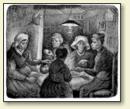| Relevant paintings: 
"Lithograph, Potato eaters," Vincent van Gogh
[Enlarge]

"Potato Eaters," Vincent van Gogh
[Enlarge]
|
Dear Theo,
By the same mail you will receive a number of copies of the
lithograph. Please give Mr. Portier as many as he wants. And I
enclose a letter for him, which I am afraid you will think
rather long, and in consequence unpractical. But I thought that
what I had to say couldn't be expressed in more concise terms,
and that the chief point is to give him arguments for his own
instinctive feelings. And in fact what I write to him I say
also to you.
There is a school - I believe - of impressionists. But I
know very little about it. But I do know who are the
original and most important masters, around whom - as round an
axis - the landscape and peasant painters will turn. Delacroix,
Corot, Millet and the rest. That is my own opinion, not
formulated as it should be.
In drawing, for instance - that question of drawing the
figure beginning with the circle - that is to say taking as
one's basis the elliptical planes. A thing which the ancient
Greeks already knew, and which will continue to apply till the
end of the world. As to colour, those everlasting problems, for
instance, that first question Corot addressed to
Français, when Français (who already had a
reputation) asked Corot (who then had nothing but a negative or
rather bad reputation) when he (F) came to Corot, to get some
information: “Qu'est-ce que c'est un ton rompu? Qu'est-ce
que c'est un ton neutre?” [what is a broken tone? What is
a neutral tone?]
Which can be better shown on the palette than expressed in
words.
So what I want to tell Portier in this letter is my
confirmed belief in Eugene Delacroix and the people of that
time.
And at the same time, as the picture which I have in hand is
different from lamplights by Dou or Van Schendel, it is perhaps
not superfluous to point out how one of the most beautiful
things done by the painters of this country has been the
painting of black, which nevertheless has light
in it. Well, just read my letter and you will see that it is
not unintelligible, and that it treats a subject that just
occurred to me while painting.
I hope to have some luck with that picture of the
potato-eaters.
I also have on hand a red sunset.
In order to paint rural life one must be master of so many
things. But on the other hand I don't know anything at which
one works with so much calm, in the sense of serenity, however
much of a worry one may be having as regards material
things.
I am rather worried just now about the moving, that's no
easy job, on the contrary. But it had to happen some time, if
not now, then later, and in the long run it is better to have a
place of one's own, that's a fact.
To change the subject. How typical that saying is about the
figures of Millet: “son paysan semble peint avec la
terre qu'il ensemener” [His peasant appears to be
painted with the earth that he is sowing.] How exact and how
true. And how important it is to know how to mix on the palette
those colours which have no name, and yet are the real
foundation of everything. Perhaps, I daresay for sure,
the questions of colour, and more exactly, broken and
neural colours, will preoccupy you anew. Art dealers speak so
vaguely and arbitrarily about it, I think. So in fact do
painters too. Last week I saw at an acquaintance's a decidedly
clever, realistic study of an old woman's head, by somebody who
is directly, or indirectly, a pupil of the school of The Hague.
But in the drawing, as well as in the colour, there was a
certain hesitation, a certain narrow-mindedness, much greater,
in my opinion, than one sees in an old Blommers or Mauve or
Maris. And this symptom threatens to become more and more
general. If one takes realism in the sense of literal
truth, namely exact drawing and local colour. There are other
things than that.
Well, goodbye, with a handshake.
Yours, Vincent
At this time, Vincent was 32 year oldSource:
Vincent van Gogh. Letter to Theo van Gogh. Written 21 April 1885 in Nuenen. Translated by Mrs. Johanna van Gogh-Bonger, edited by Robert Harrison, number 402.
URL: https://www.webexhibits.org/vangogh/letter/15/402.htm.
This letter may be freely used, in accordance with the terms of this site.
|